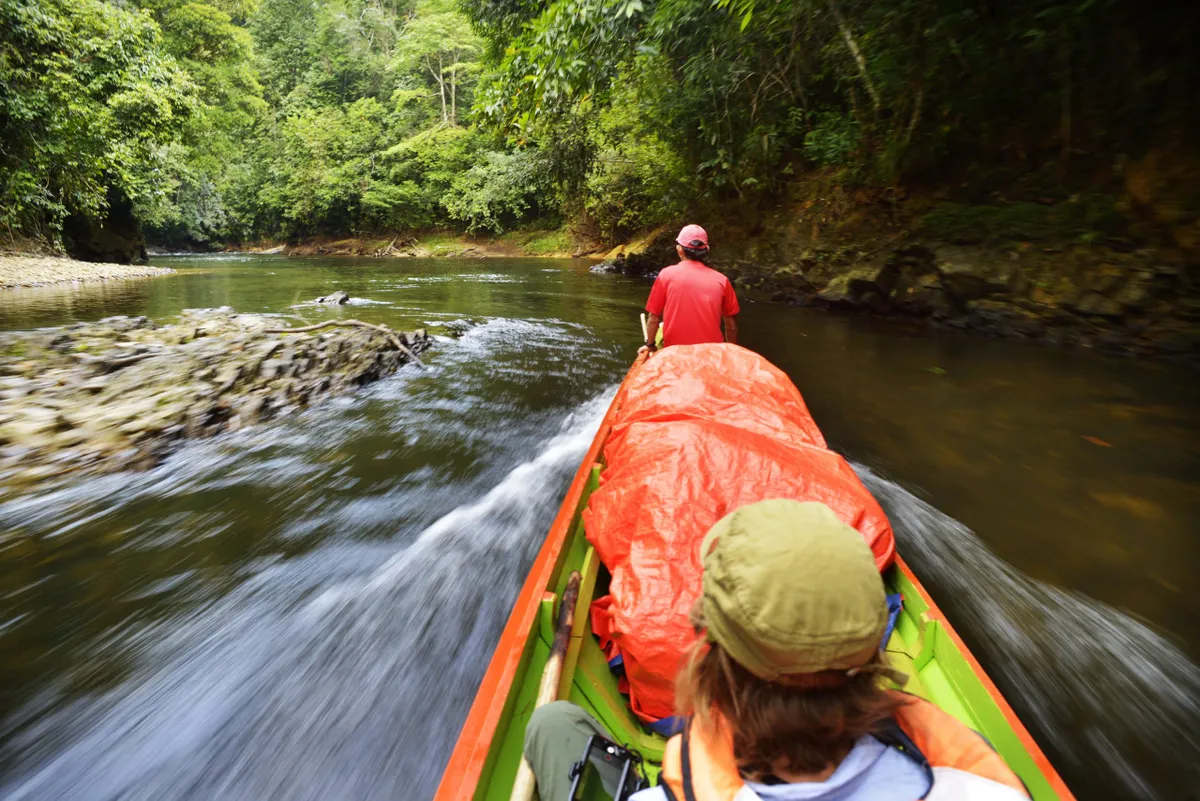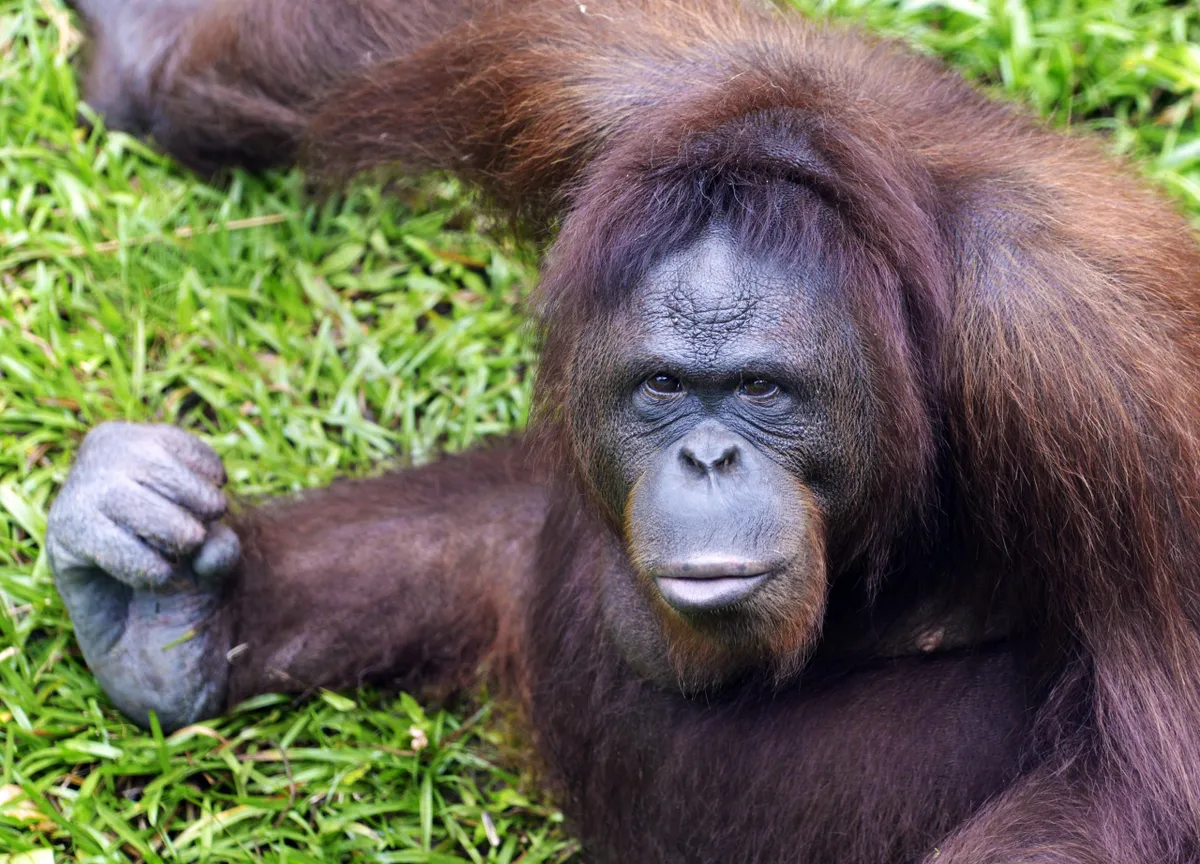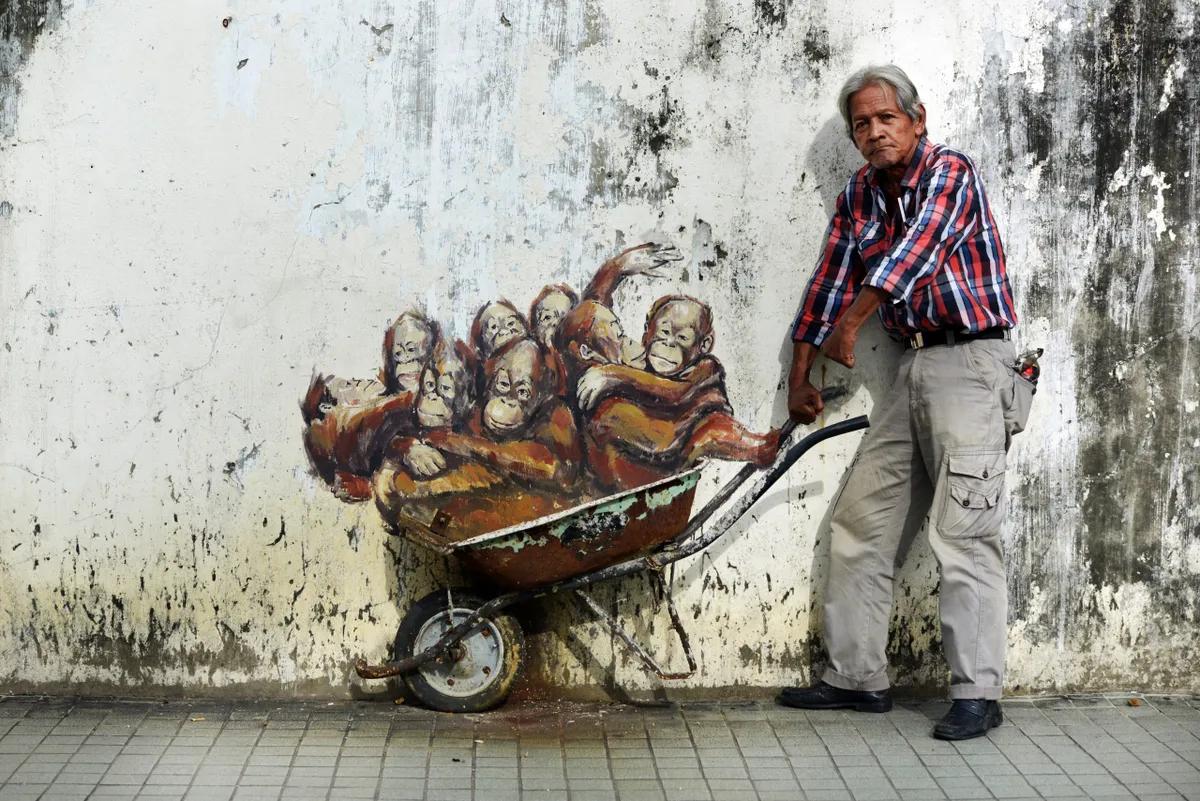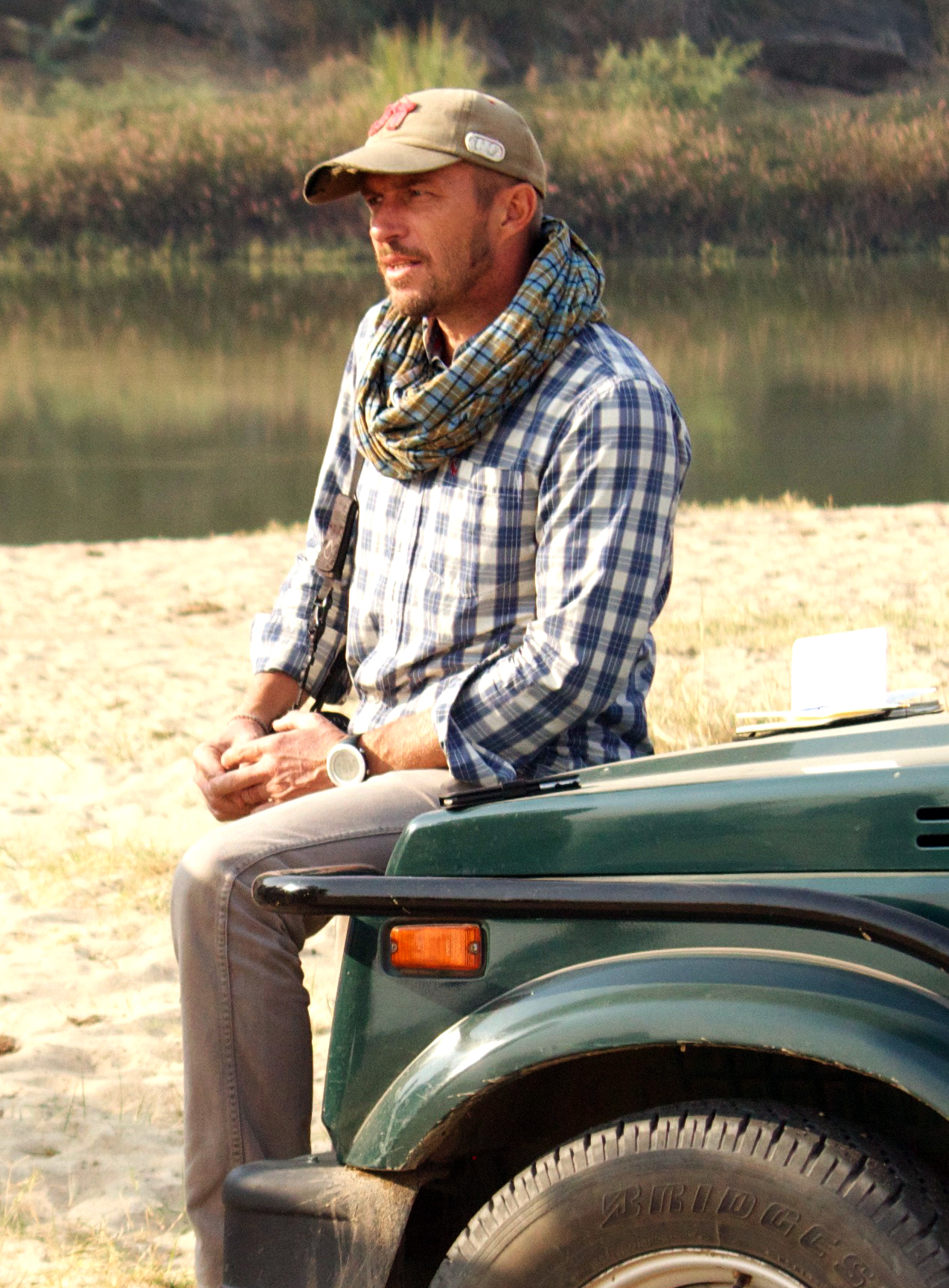My grandfather became an orangutan,” says hunter Kubi anak Mani. “In his old age, he started to grow long hair from his arms and liked to swing from the longhouse beam. Finally he just walked out into the forest.”
Instinctively I look around at the faces of the people sitting with us on the communal platform of the longhouse. They nod seriously in agreement. Although the event took place in another longhouse, they’ve heard this story too often to doubt it.
“I was in the longhouse too when that happened,” says my guide Bayang anak Penguang. “I was very small but I remember it. When Kubi’s grandfather left, he was still wearing the kandi pouch around his neck that he kept his betel nut in. For years people often saw an orangutan in the forest wearing the same kandi.”
Neighbouring Batang Ai and Lanjak Entimau National Parks are the last viable breeding range for orangutans in Sarawak on Borneo. This combined area of more than 2,000km2 of extremely diverse Bornean rainforest is home to around 2,500 orangutans. The apes here are protected by an ancient taboo that probably even predates the arrival of the Iban in this region two centuries ago.

“They can be our friends,” Bayang, a guide with local travel company Borneo Adventure, explains the next morning as we wade across the river in front of the longhouse to trek further into the rainforest in search of the great red apes.
“There are countless stories about orangutans helping people in trouble in the rainforest. If you get lost, an orangutan can show you the way home, and many travellers have escaped starvation because the orangutan showed them what to eat.”
Healing powers
We’re only a half-hour walk from the longhouse when we pass a stand of sago palms and Bayang points out a palm that has been brutally disembowelled by unimaginably powerful orangutan hands. Although there’s been little research on the subject, the orangutans may also have a tradition of herbal medicine that might be as rich as that of the Iban themselves.
Near a gurgling stream we pass a stand of spindly cane. Each plant is delicately nibbled and from tracks in the mud we can see that a big orangutan has gnawed daintily at each plant as it passed by. The plants are crawling with ants, so presumably the ape ate only what it could before the insects started to bite. It would seem to be an insubstantial meal for a 90kg ape, but perhaps there was some medicinal value to the plant.
Bayang leads me through an area of old secondary forest last cleared around a century ago. It is perfect orangutan habitat because the rainforest figs and other wild fruit are supplemented here with fruit trees introduced by Iban farmers around their ladang (dry rice fields).
Bayang explains that few people come here since the forest is haunted. I listen closely but am unable to catch a hint of the chanted singing that apparently freezes the blood of wanderers here.

Even within the cultural ‘no fire zone’ of Batang Ai National Park, the orangutans of this forest seem to have found an ideal safe haven and we have soon counted more than a dozen orangutan nests. From the condition of the drying leaves on each nest, Bayang is able to estimate with a fair degree of accuracy how old the structure is.
Since orangutans make fresh nests every day, it is easy to estimate a population and within a relatively short distance of Nanga Sumpa longhouse experts believe that there may be up to 200 individuals, making it one of the most important areas for the species in Borneo.
Sundai Silang, an Iban biologist, is one of the top experts on orangutans. “The orangutans of Batang Ai are the umbrella species for that park and neighbouring Lanjak Entimau,” he said when we met at Matang Wildlife Centre, north-west of Kuching.
“The local taboo is the key to protecting the orangutan, but together with sustainable cultural and wildlife tourism, it would be possible to safeguard an area of more than 2,000km2.” This would make it bigger than Surrey.

During my visit, 29 orangutans were in the wildlife centre, a sort of training academy for potential re-release. Certainly, at least seven of the centre’s residents would never be able to adjust to life in the wild.
A 17-year-old female called Doris is a classic case. As a baby she was ‘nurtured’ by a Western volunteer who ‘humanised’ her to the point where she still considers herself “a bit of a princess”.
“It’s very sad,” says Sundai. “She’s scared of heights so can’t climb, and she hates going into the jungle because red ants and leeches freak her out.”

Matang is located in Kubah National Park. But at only 22km2, Kubah is sadly too small ever to be a viable orangutan habitat. So the animals here are ultimately, it is hoped, destined for re-release in Batang Ai.
“The Iban–orangutan relationship in Batang Ai is a special case,” says Adelheid Munan, who has spent half a century documenting the material culture and folklore of Borneo’s indigenous communities.
“In general, Iban have mixed feelings about the orangutans. Few Iban would ever eat an orangutan except in cases of survival, but some do see them as a threat to their crops. If they respect the apes it is more often for their strength than for any spiritualism, although sometimes they view them with a sense of gratitude, as a source of revenue in areas where they can work as tourist guides.”

Gruesome meal
Over the border in West Kalimantan (Indonesian Borneo), the orangutans are less lucky. On previous trips there, I had seen orangutan skulls hanging from longhouse rafters just as I’d seen human skulls hanging in Sarawak longhouses.
Once, I’d arrived in a remote jungle camp where hunters bemoaned the fact we’d got there too late to join their orangutan feast.
“I heard that in Kalimantan, people kill female orangutans since the babies fetch a high price as pets,” a young hunter called Jalang anak Muntah, who works as a porter for Borneo Adventure, told me as we sat by our campfire deep in the Batang Ai forest. “For us they are a sacred animal, though. I never heard of anyone in this area who could do that.”
The Iban are allowed to hunt unprotected species for food (though not for sale), and Jalang is known among the Nanga Sumpa community for his hunting skills. These days, it takes a lot of skill to hunt here.
In an effort to restrict rebel or guerrilla activity, Malaysian law limits the possession of shotgun shells to just five per person at any one time. They can only be replaced if you return the empty cartridges, so hunters like Jalang must make every shot count.

The Iban in general are voracious hunters, and, apart from orangutan and respected predators such as clouded leopards and crocodiles, almost anything is considered fair game.
Tourism might be the only alternative for men like Jalang if they hope to stay in their longhouse communities, and they are now learning that wildlife can bring in revenue.
While the name orangutan means ‘jungle people’ in Malay, science recognises the Bornean orangutan as Pongo pygmaeus.
The Iban, however, argue there are three different species of ‘Maias’, as they call orangutans. Jalang tells me that the smallest and most common is Maias Kesa (charmingly named after the ubiquitous red ant) and next in size comes Maias Rambai, known for its long hair. Finally, biggest of all is the Maias Capan, known for its cheek pads, which resemble capan rice-winnowing dishes.

Has Jalang ever seen a baby Maias Capan? He shrugs: “Perhaps they go deeper into the forest to have their babies…” It’s an explanation as good as any other. After all, it is just one of many mysteries in these enchanted forests.
We are interrupted by rustling in the treetops. In the canopy across the stream, a young male orangutan is making his bed for the night. Despite thick vegetation that makes viewing difficult, this is the seventh I’ve seen in three days and – though I’ve travelled in orangutan country before, both in Kalimantan and Sumatra – I’m convinced I’ve never been in the midst of such a healthy population.
Apparently, it’s been five weeks since anyone camped here, so this young male cannot be habituated to humans and yet centuries of cohabitation have helped reassure him that the Iban and strange white-skinned people below are no danger.
Over the years, there have been occasional instances when the time-honoured truce was broken, however. When we finally arrive back at Nanga Sumpa longhouse, celebrating a successful journey over glasses of tuak (rice wine), I hear the full story of Kubi anak Mani’s orangutan grandfather. It was with a certain reticence that Kubi admitted that his grandfather had killed an orangutan.
Kill or be killed
“It was in self-defence,” he said. “The orangutan was sitting on a branch above the track. It was swaying backwards and forwards, drooling uncontrollably. My grandfather knew that it was in a trance and in a moment it would turn into a ghost and would eat him. So the only thing he could do was to kill it with his spear.”
In the weeks that followed, Kubi’s grandfather was haunted by dreams in which he was told that he would be reincarnated as an orangutan.
The Iban find nothing unusual in this. It has happened before, and as proof people can point to many graveyards in the jungle where orangutan are sighted with unusual regularity. But the strange thing was that Kubi’s grandfather was reincarnated as an orangutan before he even died.
Before he left, he had time to warn his people that they must never harm the great apes. In doing so, he added another branch to the legend that has created what might be one of the most powerful conservation taboos in the world.
And, reaching far beyond the most carefully implemented conservation strategies and wildlife legislation in the world, it is this taboo that could ultimately be the key to protecting the great red ape.
What's in a name?
‘Orangutan’ comes from the Malay ‘orang’ (person) and ‘hutan’ (from the forest). The Iban consider the orangutans of Batang Ai to comprise three forms – but, zoologically speaking, the reality is less complex.
Orangutans once ranged across a vast part of Asia, from southern China to Indochina, Malaysia, Java, Sumatra and Borneo.
Today, the Sumatran orangutan, Pongo abelii, is found only in scattered parts of the north of that island, while the Bornean orangutan, P. pygmaeus, survives as three subspecies. Sarawak and West Kalimantan are home to P. p. pygmaeus, with P. p. morio in Sabah and East Kalimantan. Southern Borneo is the last remaining bastion of P. p. wurmbii.
Update: A new species of orangutan, the Tapanuli orangutan, was described in 2017.
How to see Sarawak's wild orangutans
Borneo
- Most wildlife tour operators visit Sabah, the northern part of Malaysian Borneo, to see orangutans at locations such as Danum Valley and the Sepilok rehabilitation centre.
- Yet Sarawak, the westernmost region, has much to recommend it: huge forests, fewer visitors, spectacular wildlife and fascinating culture.
Sarawak
- Batang Ai is the best place to watch wild orangutans in Sarawak. It’s not necessary to make a long trek into the park – many visitors get lucky even within a short walk of the accommodation at Nanga Sumpa Lodge (just across the stream from the longhouse). You can book a three-day tour from the capital Kuching with Borneo Adventure.
Tour operators
- Borneo Adventure also offers a five-day ‘Red Ape Trail’ featuring a more intrepid expedition to Mawang River jungle camp, which includes transfers from Kuching, boat travel upriver, guides and porters.
- Rickshaw Travel offers an eight-day ‘Wild Heart of Borneo’ tour that takes in Batang Ai, as well as Semenggoh Orangutan Centre, Bako National Park and Kuching.
Mark Eveleigh is a travel writer, photographer and frequent visitor to Borneo. Visit his website to find out more.
This article originally appeared in BBC Wildlife. Take a look inside the current issue and find out how to subscribe.
Main image: 'Orangutan' literally translates as 'person of the forest'. Mature males have large cheek pads. © Mark Eveleigh
